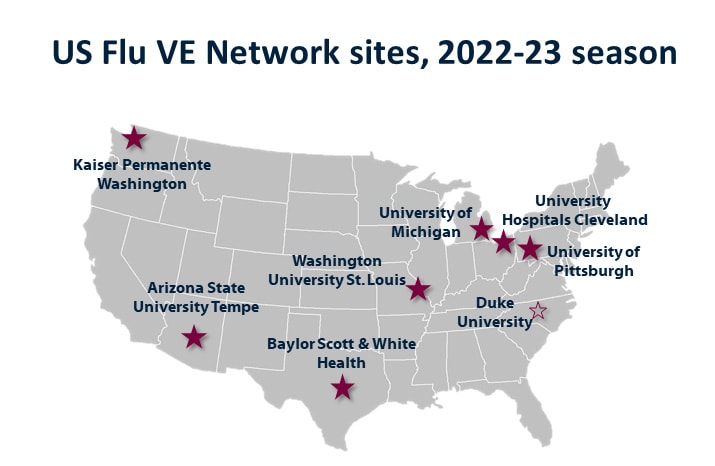US Flu VE Network
The U.S. Flu Vaccine Effectiveness (VE) network is designed to provide estimates of clinical effectiveness of licensed flu vaccines by age group and by influenza (flu) virus type and subtype.
The network consists of seven study sites and one coordinating center (Duke University) spread across the United States:
- Arizona State University Tempe (Arizona);
- University of Michigan (Michigan);
- Washington University at St. Louis (Missouri);
- Duke University (North Carolina);
- University Hospitals Cleveland (Ohio);
- University of Pittsburgh (Pennsylvania);
- Baylor Scott & White Health (Texas);
- Kaiser Permanente Washington (Washington).
Enrollment in the annual study to measure VE begins after laboratory-confirmed flu cases are reported in local surveillance for two consecutive weeks and continues for the rest of flu season.
The study uses a test-negative design which compares vaccination rates among persons with confirmed flu illness versus persons with similar illness who do not have flu based on laboratory tests. More information on the study methods used by the U.S. Flu VE Network is available at Study Design Factors.
Vaccination status is defined as receipt of at least one dose of the current season’s flu vaccine according to medical records, immunization registries, and/or self-report.
Patients are eligible if they are older than 6 months of age (thus being eligible to receive flu vaccination) and have reported acute respiratory illness with fever or new cough within the last 10 days.
Eligible patients complete an enrollment interview and answer basic questions regarding their flu vaccination status, age, underlying health conditions, and other characteristics. Flu vaccination status is later confirmed by reviewing records and immunization databases.
Following enrollment, a respiratory specimen is collected and tested for influenza virus using specific laboratory tests based on reverse transcription polymerase chain reaction (RT-PCR). Influenza viruses are then tested for influenza virus type A or B and subtype (i.e., H1N1 or H3N2).
Estimates are adjusted for study site, age, sex, self-rated general health status, race, Hispanic ethnicity, interval from onset to enrollment, and calendar time.
- More information about how CDC’s VE studies are conducted and how to interpret results is available at How Flu Vaccine Effectiveness and Efficacy are Measured: Questions and Answers for Health Professionals.
- Seasonal Influenza Vaccine Effectiveness Studies show the overall adjusted VE and related references for each season starting in 2004-2005.

